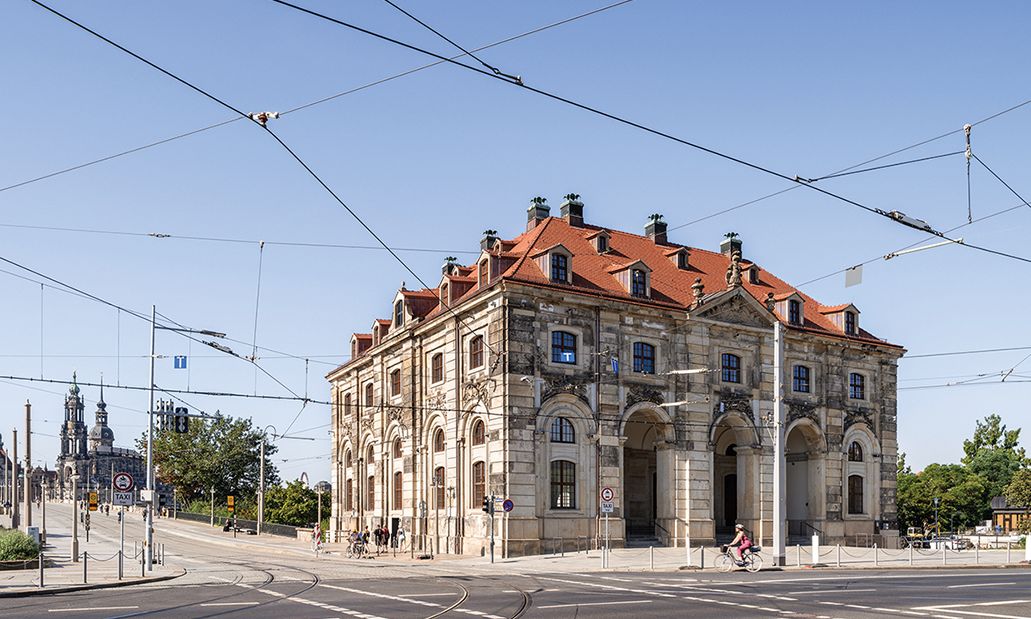Dresden’s restored Blockhaus now houses the Archive of the Avant-Garde and the 1.7 million items of the Egidio Marzona Collection
Klemens Renner
An 18th-century Baroque guardhouse containing a gigantic concrete cube suspended above the ground is the home of a new exhibition space, archive and research centre opening to visitors 5 May on the northern bank of the River Elbe in Dresden, Germany.
Designed by the Spanish-German architectural firm Nieto Sobejano Arquitectos, the Archive of the Avant-Garde took six years and €29m to build. Funded by the state of Saxony, it houses the encyclopaedic collection of 1.7 million items that Egidio Marzona donated to the Dresden State Art Collections in 2016 and 2018.
The concept of the new institution is “not that of a classical museum, but an extraordinary blend of archive, research, presentation and encounter”, the state of Saxony says in its description. The goal, it adds, is to create a “vibrant, interdisciplinary, global and future-oriented institution that brings to life the visionary body of thought of the 20th century”.
Known as the Blockhaus, the former guardhouse is now a blend of the historical and the ultra-modern. Augustus the Strong, the elector of Saxony and king of Poland, had a say in the original 1732 design. Over the centuries the Blockhaus bore witness to numerous famous events.
Like much of Dresden—known as Florence on the Elbe before the Second World War for its many architecturally significant buildings—the Blockhaus was heavily bombed in the Allied air raids of February 1945. The burnt-out building lay in ruins for 35 years until a reconstruction was completed in 1982, after which it was used again for official events as the House of German-Soviet Friendship. Following German unification, it housed a number of institutions including the Saxon Academy of Arts but suffered severe damage once more in the Elbe floods of 2013 and was forced to close.
The recent renovation entailed gutting the building and reducing it to a roofless box—just the heritage-protected exterior walls with their original façades remained intact. These were carefully restored, while the new interior is completely modern, with a self-supporting, exposed concrete spiral staircase and the spectacular, apparently floating cube, which extends over three floors and houses the archive. The new roof respects the geometry of the original building, and the foyer will serve as exhibition space.
The founder of a gallery and a publishing house, Marzona began collecting in the 1960s. He focused not only on paintings and drawings but also on documents such as letters, manuscripts, sketches, invitations and stickers relating to visual arts, literature, philosophy, dance, theatre, film and politics.
Two years before he donated the archive to Dresden, Marzona signed an endowment agreement with the Prussian Cultural Heritage Foundation, which runs Berlin’s state museums. He transferred ownership of 372 works from his collection to Berlin, including pieces by Daniel Buren, Richard Long, Charlotte Posenenske and Garry Kuehn. He also bought an abandoned castle in eastern Germany to create Design Akademie Saaleck, a foundation offering stipends to architects, designers and craft experts.
Marzona’s gift to Dresden consists of about 8,000 works of art, prints, and furniture and design objects, along with 461,000 archival documents. It also includes films, records, 10,300 posters and almost 200,000 books and magazines. The collection encompasses Expressionism, Futurism, Dadaism, Constructivism, Pop, Fluxus and post-Modern art.
The first temporary exhibition in the new Dresden institution is called Archive of Dreams: A Surrealist Impulse. It opens 5 May and runs until 1 September. With 350 20th-century works, it reflects the “fantasies and yearnings but also nightmares” of artists of various avant-garde movements including Dada and Surrealism. A second show in the autumn will focus on visionary architectural designs, many of which were never realised.

